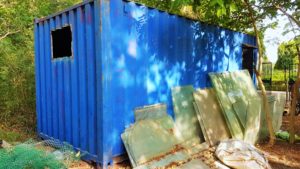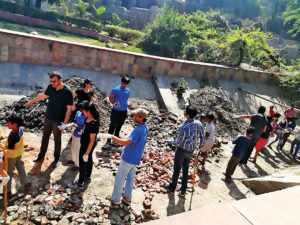Tarun Nanda leads a life that leaves no carbon footprint. His life is his message. He plans to build a home, a research and a training centre using containers
Tarun Nanda, 37, lives in a room on the fourth floor in Hauz Khas Village. His balcony overlooks the lake that he has been instrumental in cleaning by employing a fairly innovative method, which leaves no carbon footprints. A method that doesn’t involve the use of electricity, machinery, chemicals or for that matter, an operator.

A thick, toxic green layer of algae used to float on the water surface, forming an impregnable layer, stifling oxygen and making it a dead pool. That’s now a thing of the past. He released hundreds of wetland islands held together by mesh in the lake. These islands absorbed the organic waste. Now he, along with his partner, Debayani Panja, have been given the responsibility for the upkeep of the lake and its surroundings.
Panja worked for an environmental research firm where Nanda was working as a consultant — it was a boring desk job that she abhorred. The two like-minded people met and decided to work together. They co-founded an NGO, Evolutionary, a couple of years ago to explore the revolutionary ways of making people’s lives better by using ecological methods.
Evolutionary has signed an MoU with the Delhi Development Authority (DDA) for the revival and maintenance of the Hauz Khas lake. They, like the foot soldiers of nature, spend a sizeable part of their day in the upkeep of the lake. Though they have not been able to garner any formidable financial support, their indefatigable spirit keeps them going. They are fast emerging as the green ambassadors of the city.
Nanda walks around the lake, armed with a long bamboo stick — lathi. He doesn’t allow people to treat the ruins as a place where they can urinate and defecate. He also stops tourists if they are seen littering. Once he and Panja confronted a man who was picnicking with his family. He had forcefully made a young girl — a ragamuffin in appearance — vacate her spot under the shade of a tree to accommodate his family. Nanda confronted the man and an argument ensued. But eventually, they left. He was a typical specimen of people who recklessly litter public places, even though they keep their homes sparkling clean, and feel entitled to treat the poor shabbily. Nanda is a hero of urchins here, who play in the blistering sun.
So strong is his association with the place that he plans to create a research facility and host events and seminars to sensitise people, especially children, about clean and pollution free environment. For this, he wants to get some containers, place them next to each other, or on top of each other, and use the space to carry out his environment sensitisation initiatives. This is his next big initiative, an abode and work place housed inside containers nestled in nature, close to the pond.

To understand this initiative better, it’s imperative we peep into his life in Delhi. Nanda, half Indian and half Dutch, studied in England. He had a paying job before he shifted to Delhi around nine years ago. He has shifted many places and has had a difficult time with some of the landlords.
His present den — the room — is an extension of his self. A very personal space, therefore not for public display. But he made the cardinal error of having a journalist over. His room, a complete living space, fairly organic in the way it has evolved, is demonstrative of his next project — to live in a container and serve the cause of environment.
There’s a method in the muddle that he has created; each article has a certain function. It stands out, yet blends seamlessly with the rest of the space. Not done deliberately, the space has evolved overtime rather intuitively, and there’s a discernible pattern quintessential to him. Objects, big and small, are so placed that nothing really is hidden.
A table in front of the couch–appears like a throne — and on the far end of the table is a queen-sized bed. Things that he needs relatively more often are placed closer to the core. Things that aren’t required on a daily basis are lying along the periphery of the room — like his tool box, visible and accessible yet distant. Even the trash — at least one meal a day is courtesy free home delivery — is neatly stashed away in paper bags waiting to be disposed and looks like fallen soldiers waiting for honourable burial.
Behind the bed is a big window that overlooks the lake. There are a few open storage shelves along the walls. Cluttered but neat, with not a fly buzzing around or a cockroach crawling out of his tool box. Nanda’s room reminds me of an unpacked suitcase. As they say, nature expresses itself in paradoxes, I couldn’t agree more sitting in his room.
He’s a great supporter of using containers and converting them into healthy living spaces. Not just are they cost effective, but are also environment friendly. Being fairly flexible building blocks, one can expand them laterally or keep one container on top of another, replace walls with glass and make your own additions or alterations. “See what I do with it in a month,” he says. Not just that, you can transport a container to a new place and continue living in familiar settings. The work on a versatile and cheap home has begun. He’s a trend setter.
Nanda and Panja found their first container in an area which is becoming a dumping ground behind AIIMS hospital. The authorities put out a notice, and when there was no claimant, the container, fairly intact, was passed on to them. “The container is in a better condition than the ones offered to us for a price,” says Nanda. A container costs about Rs 1.5 lakh.
They placed the container close to the pond under the shade of trees. The work has already started. They got glass-panels for free from the village that they will employ to refurbish the container. They plan to buy more containers to convert it into a venue for training, research a nature testing lab.
Nanda has made a clear progression towards his goal by demonstrating sustainable ways of living and serving environment in a city like Delhi, which has the dubious distinction of being one of the most polluted and populated cities in the world. His life is his message, which in part, is also a rejection of the way world functions by eroding the environment. He leads an unorthodox life, perhaps, to streamline all his energies towards his cherished goal.
Smoking a cigarette, he gives a glimpse of his vision. To create an expansive space, close to a water body, by employing natural materials and processes for people to live in harmony with nature. An alternative way of living that seems close to bio-mimicry. And when he elucidates his vision instinctively by throwing words at you in quick succession — recycling, solar geysers, solar panels — all you want to do is hurl back the word: Amen!





